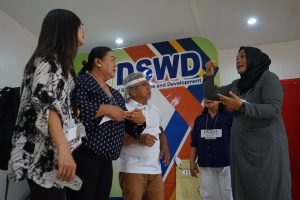The Department of Social Welfare and Development (DSWD) Field Office 7 promotes Filipino Sign Language to gain more advocates, learners, and practitioners to ensure that Deaf persons are not left behind.

Republic Act 11106 declares Filipino Sign Language (FSL) as the national sign language of the Filipino Deaf and the official sign for all government transactions involving the Deaf. The law requires schools, broadcast media, and workplaces to use the FSL.
As one of the agencies that serve the PWD sector, DSWD conducted the Basic Sign Language of the Deaf in Cebu on April 1-5, 2024 with participants from different regions, mostly staff of the centers and residential care facilities.
The staff assigned to the CRCFs deemed the use of FSL necessary to enhance communication with vulnerable children and women who are Deaf and victims of different types of abuse, as well as for PWDs who do not have or lack formal education and training in sign language. It is also helpful in various stages of rehabilitation, such as assessment, counseling, and day-to-day interactions.
During the training, participants learned FSL vocabulary and sign parameters suited to the needs of the Filipino Deaf. Basic greetings, survival signs when conversing with the Deaf, the sign alphabet, and commonly used words in social service settings using Visual-Gestural Communication (VGC) were among the topics taught.
VGC, a form of non-language communication, involves and uses gestures, facial expressions, body language, and pantomime. Through VGC, non-deaf people will develop skills to interact with individuals who are deaf or hard of hearing.
This non-language communication is used for asking, giving instructions, and conversing with a deaf person and in writing or drawing on paper or using gadgets or objects to communicate better and explain a point.
Jessica Mae Laygo, one of the trainers, said FSL is crucial in developing the Filipino Deaf community. “We will be glad to see DSWD social workers able to communicate with the Deaf easily using FSL and VGC. By then, the Deaf would be listened to and understood,” she said, using sign language.
Participants also applied their training to the deaf clients of Area Vocational Rehabilitation Center (AVRC) II by presenting children’s stories and role-playing scenarios of different settings, like emergencies and disasters, using FSL to develop new skills and reinforce their learnings by practicing in various settings.
In her message of support, Regional Director Shalaine Marie S. Lucero encouraged not only center-based staff but also the public to advocate, learn, and practice the use of FSL while highlighting the relevance of training in addressing gaps and communication barriers within the Deaf community.
“We want the Filipino Sign Language to become our way of life. Not only do we communicate because there is a Deaf person, but because we have a genuine concern for the Deaf community. It starts by communicating with them with basic greetings and involving them in little conversations using fun and creative signs,” she said.

Learning FSL makes easy
The Deaf and Terp is a group of professional interpreters and Deaf trainers working together to help the sector get full access to a quality of life using a broad spectrum of services for Deaf persons, their allies, and partners.
They aim to expose stakeholders to their services, such as learning the FSL through conducting seminars and workshops and producing sign language materials, making FSL learning fun and easy.
Febe Sevilla, one of the interpreters during the training in Cebu, said learning FSL is a challenging yet fun and fulfilling endeavor that requires a lot of patience. “Our goal in promoting FSL is using VGC, simple yet understandable basic signs that will help an individual communicate to the Deaf community,” she mentioned.
She invited the public to learn more about their advocacy and grow their interest in FSL by visiting the website at www.deafandterp.com and joining the community of advocates by liking their social media page. ###